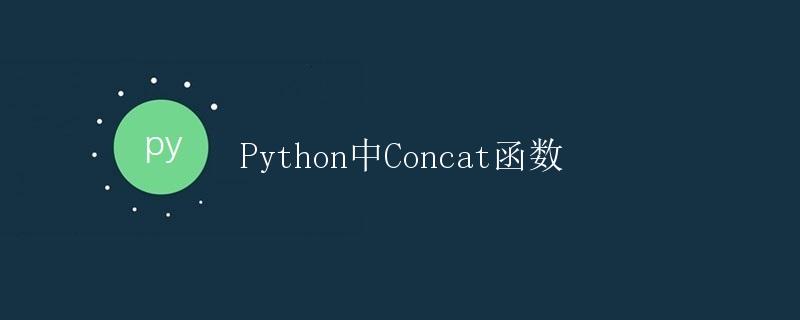Python中Concat函数

在Python中,我们经常需要对字符串进行拼接操作。为了实现字符串的拼接功能,Python提供了多种方法,其中之一就是使用concat()函数。本文将详细介绍Python中的concat()函数的使用方法和相关注意事项。
1. concat()函数的基本用法
Python中的concat()函数可以将两个或多个字符串进行拼接,并返回拼接后的新字符串。其语法如下所示:
result = str.concat(str1, str2, ...)
上述代码中,str1、str2等参数表示需要拼接的字符串,result是拼接后的新字符串。
下面是一个简单的示例代码:
# 示例代码1
str1 = "Hello"
str2 = " World"
result = str.concat(str1, str2)
print(result)
输出:
Hello World
在上述示例中,我们定义了两个字符串str1和str2,然后使用concat()函数将它们进行了拼接,并将结果赋值给result变量。最后,通过print()函数打印出result的值,即拼接后的字符串。
2. concat()函数的注意事项
在使用concat()函数时,需要注意以下几点:
2.1 参数类型
concat()函数的参数类型必须是字符串类型。如果有非字符串类型的参数,需要先将其转换为字符串类型后再进行拼接。可以使用str()函数进行类型转换。
下面的示例代码展示了参数类型不正确的情况:
# 示例代码2
num = 10
str1 = "The number is "
result = str.concat(str1, num)
print(result)
输出:
TypeError: can only concatenate str (not "int") to str
在上述示例中,由于num变量的类型是整数(int),而concat()函数要求参数必须是字符串类型,因此会抛出类型错误(TypeError)。
为了解决这个问题,我们可以使用str()函数将num转换为字符串类型,然后再进行拼接:
# 示例代码3
num = 10
str1 = "The number is "
result = str.concat(str1, str(num))
print(result)
输出:
The number is 10
2.2 返回值类型
concat()函数的返回值是拼接后的新字符串。需要注意的是,concat()函数不会修改原始字符串的值,而是创建一个新的字符串对象。
下面的示例代码展示了这一点:
# 示例代码4
str1 = "Hello"
str2 = " World"
result = str.concat(str1, str2)
print(result)
print(str1)
print(str2)
输出:
Hello World
Hello
World
在上述示例中,即使我们使用concat()函数将str1和str2进行了拼接,str1和str2的值仍然保持不变。只有result变量的值发生了改变。
3. 更多示例
下面给出一些更多的示例代码,展示了concat()函数在实际应用中的一些常见用法及其运行结果。
示例1:拼接多个字符串
# 示例代码5
str1 = "Hello"
str2 = " World"
str3 = "!"
result = str.concat(str1, str2, str3)
print(result)
输出:
Hello World!
示例2:拼接字符串和数字
# 示例代码6
num = 2022
str1 = "The year is "
result = str.concat(str1, str(num))
print(result)
输出:
The year is 2022
示例3:拼接字符串和布尔值
# 示例代码7
is_true = True
str1 = "The value is "
result = str.concat(str1, str(is_true))
print(result)
输出:
The value is True
示例4:拼接字符串和列表
# 示例代码8
fruits = ["apple", "banana", "orange"]
str1 = "My favorite fruits are "
result = str.concat(str1, str(fruits))
print(result)
输出:
My favorite fruits are ['apple', 'banana', 'orange']
示例5:拼接字符串和字典
# 示例代码9
person = {"name": "Alice", "age": 25, "city": "New York"}
str1 = "Person info: "
result = str.concat(str1, str(person))
print(result)
输出:
Person info: {'name': 'Alice', 'age': 25, 'city': 'New York'}
以上是使用concat()函数的一些示例代码,展示了不同场景下对字符串进行拼接的情况。希望本文能够帮助读者更好地理解Python中concat()函数的用法。不过需要注意的是,由于Python中字符串是不可变类型,因此频繁拼接大字符串会导致性能下降,此时可以考虑使用join()函数进行字符串拼接。
 极客教程
极客教程